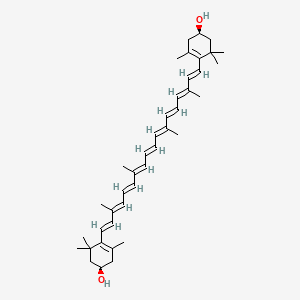Zeaxanthin
Zeaxanthin is a lipid of Prenol Lipids (PR) class. Zeaxanthin is associated with abnormalities such as Disintegration (morphologic abnormality), Alkalemia, Age related macular degeneration, Visual impairment and Consumption-archaic term for TB. The involved functions are known as Signal, Regulation, Energy Transfer, Process and Pigment. Zeaxanthin often locates in Chloroplast thylakoids, reaction center, Tissue membrane, PSII associated light-harvesting complex II and Thylakoid Membrane. The associated genes with Zeaxanthin are PRB2 gene, Structural gene, Polypeptides, Genes, Bacterial and Genes, rRNA. The related lipids are Membrane Lipids, Micelles, Fatty Acids, Lipid Peroxides and monogalactosyldiacylglycerol. The related experimental models are Knock-out.
References related to abnormalities published in Others
| PMID | Journal | Published Date | Author | Title |
|---|---|---|---|---|
| 10220393 | Proc. Natl. Acad. Sci. U.S.A. | 1999 | Polívka T et al. | Direct observation of the (forbidden) S1 state in carotenoids. |
| 11731147 | FEMS Microbiol. Lett. | 2001 | Rosa-Putra S et al. | Zeaxanthin and menaquinone-7 biosynthesis in Sphingobacterium multivorum via the methylerythritol phosphate pathway. |
| 12656178 | Int. J. Syst. Evol. Microbiol. | 2003 | Berry A et al. | Paracoccus zeaxanthinifaciens sp. nov., a zeaxanthin-producing bacterium. |
| 20698886 | FEMS Microbiol. Ecol. | 2010 | Weinert N et al. | Bacterial diversity on the surface of potato tubers in soil and the influence of the plant genotype. |
| 19376893 | Appl. Environ. Microbiol. | 2009 | Weinert N et al. | Rhizosphere communities of genetically modified zeaxanthin-accumulating potato plants and their parent cultivar differ less than those of different potato cultivars. |
| 17553786 | J. Biol. Chem. | 2007 | Johnson MP et al. | Elevated zeaxanthin bound to oligomeric LHCII enhances the resistance of Arabidopsis to photooxidative stress by a lipid-protective, antioxidant mechanism. |
| 22582723 | FEMS Microbiol. Lett. | 2012 | Hameed A et al. | Siansivirga zeaxanthinifaciens gen. nov., sp. nov., a novel zeaxanthin-producing member of the family Flavobacteriaceae isolated from coastal seawater of Taiwan. |
| 24872450 | Proc. Natl. Acad. Sci. U.S.A. | 2014 | Ballottari M et al. | Regulation of photosystem I light harvesting by zeaxanthin. |
| 25527162 | Arch. Biochem. Biophys. | 2015 | Apanasenko IE et al. | Solubilization and stabilization of macular carotenoids by water soluble oligosaccharides and polysaccharides. |
| 26541886 | Prog Retin Eye Res | 2016 | Bernstein PS et al. | Lutein, zeaxanthin, and meso-zeaxanthin: The basic and clinical science underlying carotenoid-based nutritional interventions against ocular disease. |
| 27538825 | J. Lipid Res. | 2016 | Thomas SE and Harrison EH | Mechanisms of selective delivery of xanthophylls to retinal pigment epithelial cells by human lipoproteins. |
| 25972257 | Ophthalmology | 2015 | Glaser TS et al. | The Association of Dietary Lutein plus Zeaxanthin and B Vitamins with Cataracts in the Age-Related Eye Disease Study: AREDS Report No. 37. |
| 24829491 | Am. J. Clin. Nutr. | 2014 | Koo E et al. | Macular xanthophylls, lipoprotein-related genes, and age-related macular degeneration. |
| 26482868 | Free Radic. Biol. Med. | 2015 | Olchawa MM et al. | Zeaxanthin and α-tocopherol reduce the inhibitory effects of photodynamic stress on phagocytosis by ARPE-19 cells. |
| 25422428 | Proc. Natl. Acad. Sci. U.S.A. | 2014 | Sylak-Glassman EJ et al. | Distinct roles of the photosystem II protein PsbS and zeaxanthin in the regulation of light harvesting in plants revealed by fluorescence lifetime snapshots. |
